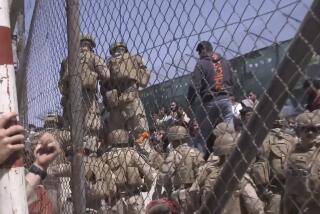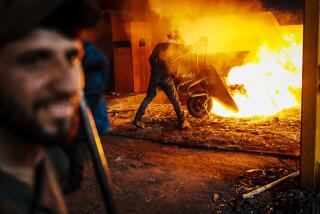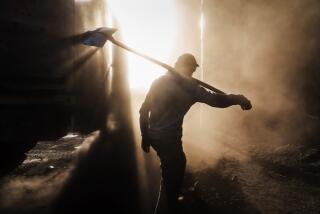As ‘insider attacks’ grow, so does U.S.-Afghanistan divide
- Share via
KANDAHAR, Afghanistan — Army Spc. Steve Beaty was on alert for signs of danger, well aware of a surge in attacks on U.S. troops by Afghans wearing police or army uniforms. The guard approaching him in a bulky coat, hands crossed at his waist, looked suspicious.
With the Afghan only 15 feet away, Beaty raised his M-4 rifle. It was then that the guard detonated his suicide vest, shooting ball bearings and shrapnel across a landing zone where two dozen American soldiers, CIA operatives, interpreters and Afghan intelligence officials had just arrived on two helicopters.
“It was a crack, a sharp-sounding explosion, and then I saw people down, and others going down,” said Spc. Mike Juhola, a 40-year-old Army medic.
Beaty yelled that he was hit. An interpreter was bleeding heavily from a leg and screaming. A CIA officer nicknamed Cowboy cradled the head of another agency operative in his lap. Spc. Brittany Gordon, a 24-year-old Army intelligence analyst, lay crumpled on the ground, a massive wound in the back of her head. Afghan intelligence officers and other U.S. soldiers were sprawled nearby.
The Oct. 13 attack near the border with Pakistan, like dozens of others this year, was carried out by a member of Afghanistan’s security forces. Abdul Wali had joined the National Directorate of Security, Afghanistan’s intelligence service, after six years as a border guard. He had no known ties to the Taliban or personal grievances. His motive may never be known.
Interviews with commanders and soldiers in Kandahar provided graphic details of several so-called insider attacks and illustrated how deeply they are dividing U.S. forces from the Afghan army and police units the Americans have promised to mentor, train and fight with for at least two more years.
“As we decide whether to do an operation now, is the main risk from the enemy? Or from our own partners?” said Lt. Col. Patrick Michaelis, a U.S. battalion commander in Kandahar.
U.S. and Afghan units still fight and train closely together every day, but often there is wariness and suspicion.
There have been 41 insider attacks by Afghan soldiers and police this year, killing 35 Americans and 22 people from other countries with forces in Afghanistan. Cmdr. William Speaks, a Pentagon spokesman, said “significantly more” Afghans than foreigners have died in the attacks.
The U.S. military now is employing “guardian angels,” armed troops who keep watch whenever American personnel are in the vicinity of Afghan allies. It is erecting higher blast walls and razor wire. U.S. forces are limiting joint operations and constructing separate, armed compounds at bases where they once lived side by side with the Afghan army and police.
Until recently, guards would wave Col. Rhamatullah Atrafi through when the top police official in Kandahar arrived for his regular security meeting at Camp Nathan Smith, the U.S. base in the city.
But recently they ordered him out of his vehicle and used a bomb-sniffing dog to check him for hidden explosives.
When he finally was allowed in, Rhamatullah was seething.
“I have always been able to park inside. Now I have to leave my vehicle at the gate,” he complained in a steely voice after sitting down with Michaelis. “So I will not come here again.”
Rhamatullah’s anger gradually eased as the discussion turned to security threats in Kandahar. But their exchange illustrated the difficult task American officers face as they try to maintain working relationships with Afghan security officials.
Kandahar is the Taliban’s spiritual home and securing it has been a key goal for years. But the U.S. was already shrinking its combat role and turning security responsibility over to the Afghan army and police when the insider attacks intensified over the summer. In place of combat troops, 18-to-22-person teams of American advisors were formed to live and train with Afghan units, with the aim of bolstering their capabilities before the U.S. pullout in 2014.
The risk of placing the small teams in joint bases became clear June 19 when an Afghan policeman named Haji Bismullah arrived at the gate of a small base on Kandahar’s west side with four men in fresh uniforms in the back of a green pickup. They were new recruits, he told the guards, as he drove through the gate at 5:55 a.m.
Bismullah dropped the four men off and sped away.
Splitting into two teams, the men attacked, firing AK-47s into tents where many of the more than three dozen Afghan police and U.S. soldiers were still sleeping. Two made straight for the bunk of Capt. Abdul Kaduz, the Afghan commander.
Sgt. P.J. Dunlevy, an American soldier who had gotten up early, came face to face with the two other attackers. One raised his rifle and pulled the trigger. It jammed.
Dunlevy sprinted away, hearing a burst of bullets behind him.
Armed only with a pistol, he ran to the small operations tent, joining three other soldiers inside. They radioed a nearby U.S. outpost for reinforcements and counted their ammunition.
On security monitors inside the tent, they saw the Afghan gunmen walking methodically around the camp, firing and throwing grenades.
“We were prepared to die in place,” Dunlevy recalled later in an interview. “I thought everybody else was dead.”
Lt. Col. Matthew McKinley said that when the shooting started he was near the latrine with Thomas Boyle, a 62-year-old retired Chicago policeman who was helping to advise Afghan police.
“I said, ‘Tom we need to get under cover,’” McKinley recalled. “I ran and thought he was behind me, but he was hit right after that.”
The attack was halted 15 minutes later when Sgt. Scott Stanley shot three of the gunmen from a guard tower and Sgt. Brandon Scott, an Army cook who had been wounded by a grenade, grabbed his rifle and shot the fourth.
When the shooting stopped, Boyle, Kaduz and four other Afghan police officers were dead. A dozen U.S. soldiers, all of them reservists from Michigan, and seven Afghans were wounded.
After the insider attacks intensified in August and September, U.S. commanders in Kandahar ordered American units living on isolated bases to divide the facilities into Afghan and American halves, with armed guards, razor wire and blast walls between them.
At a small joint base along Highway 1, the main road through the city, a soldier with a machine gun keeps 24-hour watch on a gate that now divides the U.S. and Afghan side of the cramped walled compound.
The new security measures have “caused a lot of tension and a lot of strain,” said Capt. Terron Wharton. “When the Afghans see guys putting gates up that say, ‘You don’t trust me,’ that’s where the tension has been.”
Maj. Brian Schoellhorn, leader of a police advisory team at the same outpost, said the new security measures had not prevented him from working closely with the Afghan commander, Col. Farooq Parwani. But he surrounded himself with more U.S. soldiers.
“Instead of taking two guys and walking over to the headquarters, we took five,” he said, adding that Parwani “understood completely” and “in some ways it solidified our relationship.”
Not even an alert security detail could prevent the deadly suicide attack last month at the helicopter landing zone near Pakistan.
Juhola, the medic, was not injured and in the minutes after the attack he did a quick accounting of the casualties. Of the two dozen U.S. soldiers, Afghan intelligence agents, CIA officers and interpreters at the site, a dozen were in critical condition and four appeared to be dead or nearly so.
Gordon, the intelligence analyst from St. Petersburg, Fla., on her first deployment, was “in a worse state than anyone else,” Juhola recalled. Beaty suffered shrapnel wounds to his throat, face and arms, as well as a broken foot.
The CIA officer nicknamed Cowboy was helping transport the wounded to a makeshift aid station away from the landing zone, apparently only slightly injured. But after 10 minutes he slumped to the ground. No blood was visible on his shirt or his protective vest, but a piece of shrapnel had pierced his back.
Juhola and another medic worked on him with the limited supplies they had left.
“I would squeeze his hand, and he would squeeze my hand,” Juhola said. “We got him to the point where we thought he was stable.”
But as they prepared to load him aboard a Black Hawk helicopter, they saw that he was gone. So were Gordon and four Afghan intelligence agents. Their bodies were zipped into bags and flown away.
More to Read
Sign up for Essential California
The most important California stories and recommendations in your inbox every morning.
You may occasionally receive promotional content from the Los Angeles Times.














